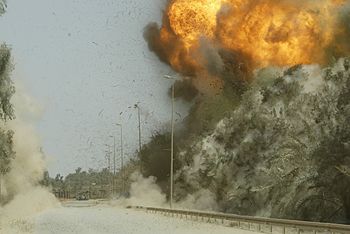- Mine-clearing line charge
-
 Detonation of a MICLIC to destroy a 1km in depth blast resistant minefield in Iraq.
Detonation of a MICLIC to destroy a 1km in depth blast resistant minefield in Iraq.
A mine-clearing line charge (abbreviated MCLC and pronounced "mick lick") is used to create a breach in minefields under combat conditions. While there are many types, the basic design is for many explosive charges connected on a line to be projected onto the minefield. The charges explode, detonating any buried mines, thus clearing a path for infantrymen to cross. The system may either be man-portable, or vehicle-mounted. The systems do not guarantee clearance of all types of mines.[1]
Contents
History
The British and Commonwealth developed their systems during the Second World War. The Canadians developed "Snake", an oversized application of the Bangalore Torpedo in 1941 to 1942. A more flexible development was "Conger", developed in 1944, a tube that could be fired across the minefield and then filled with explosive before detonation.[2]
Conger was a 2 inch woven pipe launched by a five-inch rocket. The tube and rocket were mounted in a Universal Carrier which had been stripped out to reduce it down to an armoured tracked trailer that could be towed by a tank, often a Churchill AVRE. The rocket was fired, trailing the hose across the area to be cleared. Compressed air was then used to pump the high explosive - just over a ton of 822C - into the hose before it was detonated. Conger was used in Normandy where there were instances of premature detonation.[3]
In the post war period the British introduced Giant Viper.
Current use
Systems in current use include the British Python, which can clear a 220m long path, and the American M58 Mine Clearing Line Charge. Both are large, heavy systems that are deployed in a vehicle–towed trailer. The US Army also uses the Antipersonnel Obstacle Breaching System, which clears a path 0.6 to 1.0 meters by 45 meters, and is light enough to be carried by two soldiers.
Some modern mines, such as the Italian SB-33 mine, have a fuze mechanism that detonates the mine if subject to gradual, steady pressure, but locks the fuze if subject to a sudden shock. This can defeat the use of mine-clearing line charges to clear such mines.
Examples
- Charge Line Mine Clearing (Vehicle)-Indian
- UR-77 Meteorit Mineclearing System (rocket launched explosive hose),[4] replacement of the UR-67 system based on the BTR-50PK chassis.[5]
See also
References
- ^ уБРЕТ-5(ETEL) пЗМБЧМЕОЙЕ ТБЪДЕМБ -ЙОЦЕОЕТОБС ФЕИОЙЛБ. index-texnica.html
- ^ http://www.fas.org/man/dod-101/sys/land/docs/981100-schneck.htm
- ^ Fletcher, The Universal Tank 1993 HMSO 0 11 290534 X p94
- ^ Мiнiстэрства абароны РБ - Устаноўка размініравання Ур-77
- ^ http://www.popmech.ru/part/print.php?rubricid=7&articleid=1965 Yuri Veremeyev, Zmei Gorinich and URka, Popular Muchanics, May 2007
External links
 Media related to Mine-clearing line charges at Wikimedia Commons
Media related to Mine-clearing line charges at Wikimedia Commons
This military-related article is a stub. You can help Wikipedia by expanding it.
